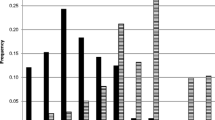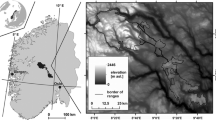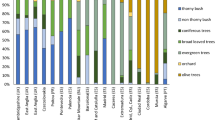Abstract
With the continuing spread of urban areas, gaining a greater understanding of the effect of human presence on wildlife species is essential for wildlife managers. We determined the influence of anthropogenic resources on home range size and habitat selection of raccoons (Procyon lotor) during summer (June–August) 1996–2000 for 120 raccoons at three sites exposed to varying levels of urbanization and anthropogenic resources, specifically food. Home range estimates were larger (P < 0.05) at the rural site than the suburban and urban sites for both genders. We used compositional analysis to examine raccoon habitat selection at the second-order home range, second-order core area, and third-order home range scales. Woodland was consistently a highly-selected habitat type for both sexes at every spatial scale. Relative to other habitat types, habitat associated with human-related food (human use areas) was selected most often at the urban site, intermediately at the suburban site, and not selected at the rural site. Spatial scale also affected habitat selection. Human use areas were preferentially selected at the second- and third-order level at the urban site, third-order level only at the suburban site, and at neither level at the rural site. Additionally, intersexual differences in habitat selection were reduced at the urban site, with both sexes preferentially selecting for human use areas as well as woodland habitat. Smaller home ranges in urbanized environments are often attributed to the abundant and concentrated anthropogenic resources associated with human activity, but with little empirical support. Our habitat selection analyses followed our predictions that raccoon foraging is strongly influenced by the artificial distribution and abundance of human-related food. Male and female raccoons in urban areas reduce their foraging patterns and focus their foraging activity on anthropogenic foods.



Similar content being viewed by others
References
Aebischer NJ, Robertson PA, Kenward RE (1993) Compositional analysis of habitat use from animal radio-tracking data. Ecology 74:1313–1325
Bingham RL, Brennan LA (2004) Comparison of Type I error rates for statistical analyses of resource selection. J Wildl Manage 68:206–212
Chamberlain MJ, Conner LM, Leopold BD, Hodges KM (2003) Space use and multi-scale habitat selection of adult raccoons in Central Mississippi. J Wildl Manage 67:334–340
Dalgish J, Anderson S (1979) A field experiment on learning by raccoons. J Mammal 60:620–622
Destefano S, Deblinger RD, Miller C (2005) Suburban wildlife: lessons, challenges, and opportunities. Urban Ecosyst 8:131–137
Ditchkoff SS, Saalfeld ST, Gibson CJ (2006) Animal behavior in urban ecosystems: modifications due to human-induced stress. Urban Ecosyst 9:5–12
Dwyer JF, Schroeder W, Buck RL (1985) Patterns of use in an urban forest recreation area. In: Wood J (ed) Proceedings of the 1985 National Outdoor Recreation Trends Symposium II. United States Department of the Interior, Atlanta, Georgia, pp 81–89
Gehrt SD (2003) Raccoons Procyon lotor and allies. In: Feldhamer GA, Thompson BC, Chapman JA, (eds) Wild mammals of North America: biology, management, and conservation, 2nd edn. Johns Hopkins University Press, Baltimore, MD, pp 611–634
Gehrt SD (2004) Ecology and management of striped skunks, raccoons, and coyotes in urban landscapes. In: Fascione N, Delach A, Smith M (eds) Predators and people: from conflict to conservation. Island, Washington, DC, pp 81–104
Gehrt SD, Fritzell EK (1997) Sexual differences in home ranges of raccoons. J Mammal 78:921–931
Hadidian J, Manski DA, Riley S (1991) Daytime resting site selection in an urban raccoon population. In: Adams LW, Leedy DL (eds) Wildlife conservation in metropolitan environments. National Institute for Urban Wildlife, Columbia, MD, pp 39–45
Hoffmann CO, Gottschang JL (1977) Numbers, distribution, and movements of a raccoon population in a suburban residential community. J Mammal 58:623–636
Hooge PN, Eichenlaub B (1997) Animal movement extension to ArcView, version 1.1. Alaska Biological Science Center, US Geological Survey, Anchorage, AK
Johnson DH (1980) The comparison of usage and availability measurements for evaluating resource preference. Ecology 61:65–71.
Kaufmann JH (1982) Raccoon and allies. In: Chapman JA, Feldhamer GA (eds) Wild mammals of North America: biology, management and economics. Johns Hopkins University Press, Baltimore, MD, pp 567–585
Lair H (1987) Estimating the location of the focal center in red squirrel home ranges. Ecology 68:1092–1101
McKinney ML (2002) Urbanization, biodiversity, and conservation. BioScience 52:883–890
McNay RS, Morgan JA, Bunnell FL (1994) Characterizing independence of observations in movements of Columbian black-tailed deer. J Wildl Manage 58:422–429
Mohr CO (1947) Table of equivalent populations of North American small mammals. Am Midl Nat 37:223–249
Montgomery GG (1969) Weaning of captive raccoons. J Wildl Manage 33:154–159
Pedlar JH, Fahrig L, Merriam HG (1997) Raccoon habitat use at 2 spatial scales. J Wildl Manage 61:102–112
Prange S, Gehrt SD (2004) Changes in mesopredator-community structure in response to urbanization. Can J Zool 82:1804–1817
Prange S, Gehrt SD, Wiggers EP (2004) Influences of anthropogenic resources on raccoon (Procyon lotor) movements and spatial distribution. J Mammal 85:483–490
Rosatte RC, Power MJ, MacInnes CD (1991) Ecology of urban skunks, raccoons, and foxes in metropolitan Toronto. In: Adams LW, Leedy DL (eds) Wildlife conservation in metropolitan environments. National Institute for Urban Wildlife Symposium Series 2, Columbia, MD, pp 31–38
Sandell M (1989) The mating tactics and spacing patterns of solitary carnivores. In: Gittleman JL (ed) Carnivore Behavior, ecology, and evolution. Cornell University Press, Ithaca, NY, pp 164–182
Sanderson GC, Nalbandov AV (1973) The reproductive cycle of the raccoon in Illinois. Illinois Nat Hist Surv Bull 31:25–85
Schinner JR, Cauley DL (1974) The ecology of urban raccoons in Cincinnati, Ohio. In Noyes JH, Progulske DR (eds) Wildlife in an urbanizing environment. Planning and resources development series number 28. Holdsworth Natural Resources Center, Amherst, MA, pp 125–130
Seaman DE, Millspaugh JJ, Kernohan BJ, Brundige GC, Raedeke KJ, Gitzen RA (1999) Effects of sample size on kernel home range estimates. J Wildl Manage 63:739–747
US Bureau of the Census (2006) Statistical abstract of the United States: 2006, 125th edn. US Bureau of the Census, Washington DC
Worton BJ (1989) Kernel methods for estimating the utilization distribution in home-range studies. Ecology 70:164–168
Acknowledgments
This study was supported by the Max McGraw Wildlife Foundation, the Forest Preserve District of Cook County, and the Furbearer Fund of the Illinois Department of Natural Resources. McHenry County Conservation District allowed access to their property. Numerous persons from the Max McGraw Wildlife Foundation assisted with fieldwork. We especially thank Chris Anchor and Brad Woodson for providing access and logistical support.
Author information
Authors and Affiliations
Corresponding author
Rights and permissions
About this article
Cite this article
Bozek, C.K., Prange, S. & Gehrt, S.D. The influence of anthropogenic resources on multi-scale habitat selection by raccoons. Urban Ecosyst 10, 413–425 (2007). https://doi.org/10.1007/s11252-007-0033-8
Received:
Accepted:
Published:
Issue Date:
DOI: https://doi.org/10.1007/s11252-007-0033-8




